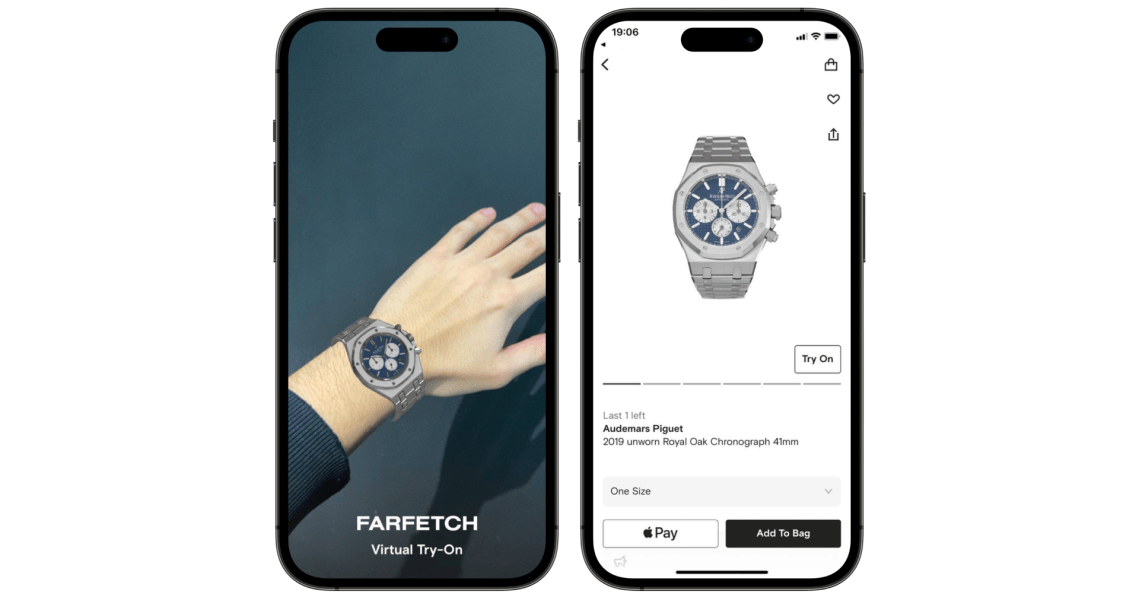Virtual try-on is becoming a key proposition for luxury retailers, and Farfetch is getting on board.
Global online fashion marketplace Farfetch recently tested how a virtual try-on offering would improve conversion and engagement. It found that, compared to going to a store to try on a product, luxury customers would rather use virtual try-on when they’re early in the path to purchase. In addition, they’d rather engage with virtual try-on offered through a QR code on a store window than enter the store.
Farfetch has heavily invested in virtual try-on technology since 2018. In 2020, it partnered with Belarusian software company WANNA to offer virtual try-on, which proved to be a commercially successful tool. It now offers virtual try-on for luxury watches, shoes, jewelry and makeup, with plans to bring the technology to its bags and ready-to-wear in the future. Currently, over 1,000 of its more than 100,000 products offer virtual try-on. The try-on option is signaled through a “Try On” label on product page images.
“We see AR on platforms like Snap and [Farfetch] as distinctly different experiences,” said Carol Hilsum, senior director of product innovation at Farfetch. “A Snap-type filter experience is far more akin to a fun entertainment piece. Our AR is more focused on: What does this mean for the shopping experience?”
In 2022, Farfetch enlisted Curie, one of the winners of its Dream Assembly, an innovation-focused accelerator program. The technology of Curie, a software company that specializes in automating 3D asset creation is being considered for future technology upgrades. Farfetch declined to disclose its investment in virtual try-on. Hilsum said the company has, so far, intentionally kept the offering limited.
“It takes a really comprehensive, full-stack approach to execute — all the way from creating 3D assets in a scalable, sustainable way to housing them,” said Hilsum. “Then you have to have the front-end tooling to be able to display the assets around this 3D view idea, making sure you can display them on both your web browser and your app, and with the virtual try-on experience on top.”
“It’s about enhancing and mimicking the physical experience with a very lifelike trial, so the customer can feel confident that [the experience] is similar to trying [something] on in-store,” she said.
Ad position: web_incontent_pos1
For the test around virtual try-on’s business impact, Farfetch zeroed in on the watch category. Over the course of a 14-week analysis period this year, Farfetch saw a 47% increase in site visits to watches equipped with WANNA’s functionality, compared to watches of a similar price point without virtual try-on. Products featuring virtual try-on are called out on search results pages. Add-to-bag increased by 22%, and add-to-wish list increased by 81%. However, Farfetch stressed that the virtual try-on analysis for watches was not subject to the company’s usual, extensive A/B testing. What’s more, the sample size was small and, therefore, indicative of a trend rather than a proven result.
“We’ve found that people will engage with virtual try-on very easily, understand it quickly and know how to play around with the digital assets almost intuitively,” said Hilsum. “That’s especially true of a younger luxury shopper; they are much more comfortable with the idea of digital assets and engaging with things digitally.”
Slight alterations to the technology and the customer experience — like enabling movement for tried-on jewelry and suggesting other items to try on — have improved engagement. In watch brand IWC Schaffhausen’s out-of-home ads and store windows in London, the brand featured a QR code linking to its AR try-on-enabled products on IWC, allowing customers to try them on in the street.
“The objective is to get customers into stores,” said Sergey Arkhangelskiy, CEO at WANNA. Before Farfetch, the company’s first customer was Gucci. It also works with IWC Schaffhausen directly. “The key thing we’ve discovered through the years is that this AR technology and virtual try-on work in many different touchpoints,” meaning people take advantage of them on all channels.
Arkhangelskiy said that virtual try-on also helps to build awareness. Considering its current novelty, consumers often share the tool with contacts and on social media. Secondly, when integrated into an app or website, virtual try-on engages existing shoppers; they navigate through more products than usual, including products they weren’t originally interested in, he said, citing data from WANNA’s work with brands.
Ad position: web_incontent_pos2
“Our initial focus was to extend the catalog beyond what was in store,” catering to in-store shoppers, said Hilsum. “But we found that people were [virtually] trying on products that were available in store, too, and trusting the experience enough to [forego] trying on the physical item.” Farfetch tested the watch experience in the stores of select brands that retail on its site.
Others used the feature early on in the buying process, “It [supports] an early stage of the buying pipeline,” she said. “Instead of trying 50 watches or bags [in a store], you can get to a shortlist just through virtual try-on.”
Virtual try-on can also be helpful in B2B operations, Arkhangelskiy said. “A luxury sneaker brand we work with uses our technology to showcase its product to wholesale partners,” he said.




